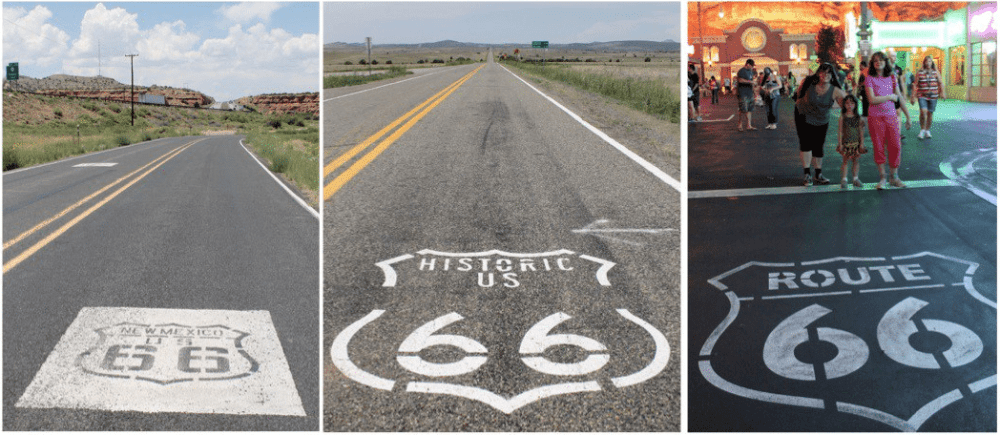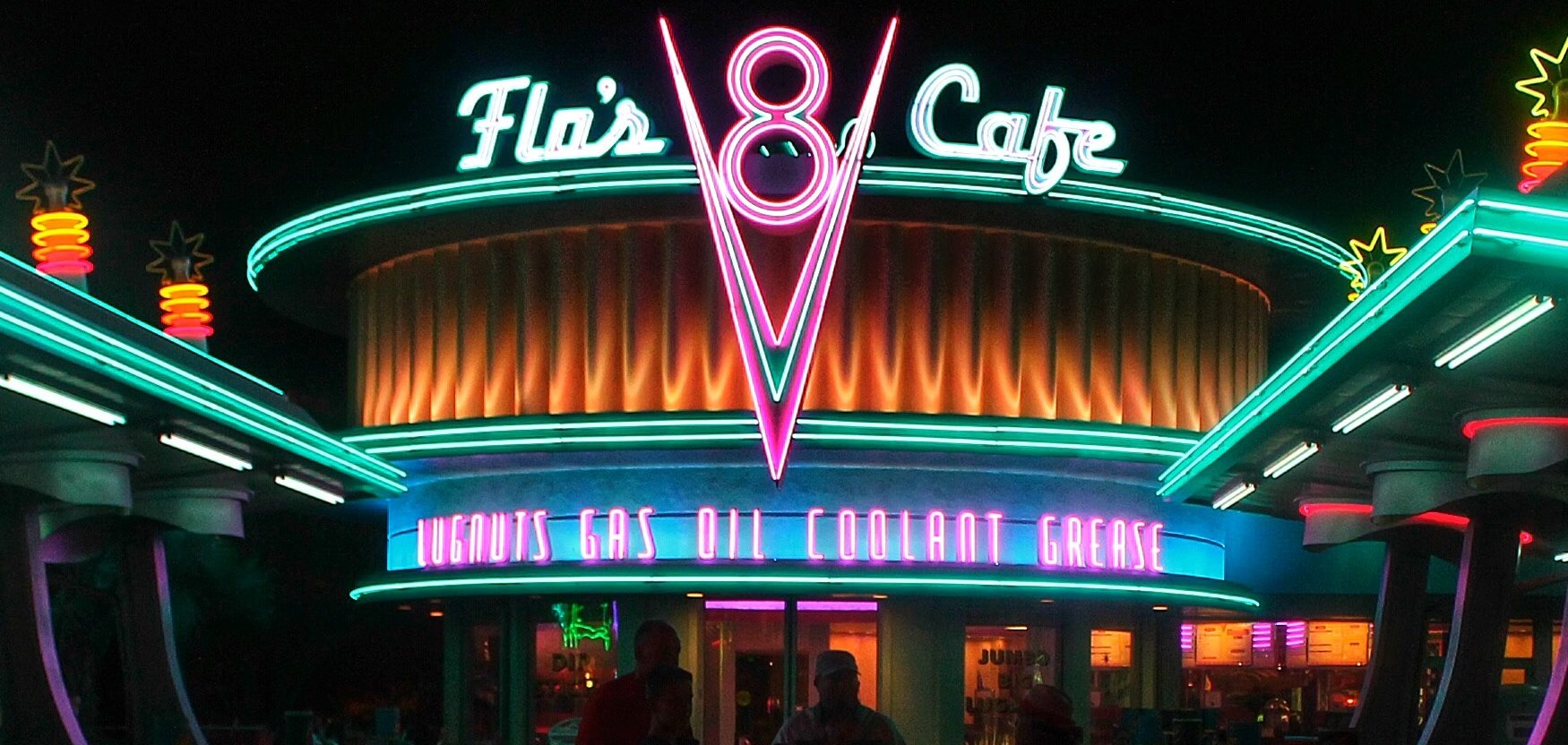
My husband, Rick, and I had talked about taking a trip down the Historic Route 66 for several years. When the Walt Disney Company and Pixar announced two years ago the addition of Cars Land, a recreation of Cars Downtown Radiator Springs, to their California Adventure Park in Anaheim’s Disneyland Resort, we decided to take action.

After several months of planning, and precisely scheduling the trip to coincide with our 20th wedding anniversary and our youngest daughter’s birthday, we set off to “get our kicks.” Time wouldn’t allow us to make the entire Route 66 drive, so we started just outside of Oklahoma City, to “motor west” the end of the road at Santa Monica Beach in California.
We knew we wanted to take in as much of the historic quirky, kitschy weirdness that was once America’s most prominent byway, but what about our daughters? Our route would be roughly 1,300 miles (a good four days of car travel), with several “back road” stops along the way. How could we make a long stretch of American concrete and often deserted buildings interesting for a 12-year-old ‘tween and a very, very active four year old anticipating her upcoming fifth birthday?
Thankfully, Disney had already done the job for us, as Disneyland Park was located in the Los Angeles area, near the end of the Route 66 line. We gave our girls the task of seeing how much of Route 66’s features they would recognize during their Cars Land visit. After all, four days at Disneyland was a good incentive to put up with what they probably felt was a traveling history lesson.
Once we reached our Disney destination, it was evening when Cars Land’s neon was in full glory. Our girls immediately begin recognizing all the details, shops, attractions, and features inspired by Route 66. Having just seen the “real deal” made the adventure that much more exciting.
Here are a few of the most obvious Cars Land/Route 66 comparisons we made:
Route 66 Road Stamps. These stenciled Route 66 shield stamps are periodically placed along the highway to mark areas of some of the original stretches of road or historic districts. Some of the signs we saw were marked with the state’s designation, and some had an extra bit of detail added, but they were all pretty much the same, classic shield design.
The over-sized Route 66 shield stamp in Cars Land was set in a centralized location, but much bigger than many of the ones on the actual highway. It was a perfect “welcome” the evening we arrived.

The “Here It Is” Sign. This sign was the tail end of an over-the-top “anticipation” method of advertising, where signs featuring the same bunny image were placed along the highway nearly every mile for around 100 miles. The idea was to wear down the driver with such a sense of curiosity, they just had to stop to see what “IT” actually was. The answer: a big fiberglass saddled bunny outside of the Jackrabbit Trading Post, between Holbrook and Winslow, Arizona. Today, only the final sign is left along the roadside, but the trading post is still open for business. The big bunny is still well cared for ready for photo ops.
The Cars Land “Here It Is” Sign is an adorable tribute to this sign, including the little “Stanley” bunnies aligning the top of the billboard. There was no giant bunny, but Mater’s “petting zoo” is near the sign, with a single tractor to pose with and pet. Unlike the jackrabbit, Disney discourages guests from sitting on the tractor.

The U-Drop Inn. Disney Pixar’s most faithful recreation of one of Route 66’s historic roadside buildings takes after Shamrock, Texas’s U-Drop Inn, and its distinct Conoco Tower. The Art Deco style building was completed in 1936, and is currently the site of the town’s Chamber of Commerce and visitor center.
The building was the inspiration for Ramone’s House of Body Art gift shop, which also boasts a unique tower and shape. Ramone’s, by the way, is the only place in Cars Land where people will find a hidden Mickey Mouse in the design. The Mickey heads aren’t easy to spot, but cast members will be glad to point out where they are found.
Also easily comparable, were the Cool Springs Camp along the windy road to Oatman, Arizona, and Lizzie’s Curio Shop.

Cadillac Ranch. Even those who aren’t interested in the Route 66 history would find the Cadillac Ranch public art installment outside of Amarillo, Texas, interesting. The installment is not right on the route, but is a popular side trip for travelers. This line of upturned Cadillacs was commissioned by eccentric art lover Stanley Marsh 3, and built by the artist group “Ant Farm.” It seems isolated in pictures, but it is nearly always swarmed by people armed with colorful spray-paint cans, wishing to contribute to the ever-changing designs. Our family was no exception, and when we left, the words “Bad Wolf” adorned on a couple of the Caddys.
Cadillac Ranch is so popular, it inspired a similar lesser-known installation, “Bug Ranch,” created with Volkswagen Beetles, in nearby Conway, Texas. Someone else had already beaten us to marking it with, “Bad Wolf,” in the exact color of paint as ours, no less.
Cars Land’s tribute to this world-famous piece of pop art is a prominent part of Radiator Spring’s “natural” landscape in Ornament Valley. Cadillac Ranch’s famed tail fins can be seen in this landscape that makes up the back drop for Cars Land’s main attraction, Radiator Springs Racers.

The Wigwam Motel. We saw all types of “giant concrete items” and shaped buildings along the route, including the big Twin Arrows in Arizona, and the Milk Bottle Building in Oklahoma. The Wigwam Motels in Holbrook, Arizona, and Rialto, California, were the most charming. Both of these sister motel sites still take guests, too, but they do tend to fill up fast.
The Cars Land answer to these is the Cozy Cone Motel, which serves are a set of five little snack booths surrounding a small food court and the motel’s lobby. In addition to being able to hang out in Radiator Springs’ most popular motel, this is also the site where Lightning McQueen and Mater take turns posing–as well as cars can–with guests.

Hackberry Gen Store and Bottle Tree Ranch. There have been several stories about the people who inspired the characters in the movie Cars. One of the possible inspirations for free-spirited Volkswagen Microbus, Fillmore, was the late artist Bob Waldmire. Waldmire supposedly wasn’t that thrilled with being associated with the fictional talking van, but his Hackberry Gen Store in Hackberry, Arizona, was certainly as creative as Fillmore’s hippy haven. The Hackberry site contains a large display of found item art, a somewhat eerie soda fountain recreation with costumed mannequins, and even a little koi pond “oasis” in the desert. Fillmore could also feel easily at home in Elmer Long’s “Bottle Tree Ranch” near Helendale, California, a front yard forest of bottle trees topped with everything from toilet seats to road signs.
The “geodesic dome” shape of Fillmore’s psychedelic-colored building was also typical of the design of a few of the remaining buildings we passed.
Another common building shape we saw again and again along the route was the cylindrical military buildings known as Quonset Huts. After World War II, private citizens and business owners, for extra garage space, surplus stores, barns, and other purposes, repurposed these huts. Sarge’s Surplus Hut gift store next to Fillmore’s was no exception, including its slightly rusted exterior.

“Burma-Shave” Signs. The Burma-Shave liniment and shaving cream first created their unique brand of roadside advertising in 1925, and was one of their major advertising means in most contiguous states through 1963.
Travelers likely won’t see many original Burma-Shave signs intact, but the well-preserved stretch of road west of Seligman, Arizona, has placed several reproductions along the route for nostalgia buffs to enjoy. This made the long stretch of empty desert highway more

entertaining.
Some of these “episodic” road sign messages were straightforward ads for the product, but many were safe driving messages in verse form. Our family favorite: “Got insurance?…Remember, kiddo…They don’t pay you…They pay your widow….Burma-Shave.”
Since cars themselves don’t shave, the Burma-Shave style signage outside the entrance to the Radiator Springs Racers advertise, of course, Rust-eze: “Mind your speed…As you go…Sheriff’s old…But he’s not slow…Rust-eze.”
Neon! Both Route 66 and Disney parks shine best at night.
Two locations where Route 66’s neon seemed stand out the most were Albuquerque and Tucumcari, New Mexico. This was no surprise in Albuquerque, since it was a main urban college-area street, but in the smaller community of Tucumcari, the restored neon signs were beautiful, most notably the Tepee Curios and the Blue Swallow Motel. We had the good fortune to spend the night at The Blue Swallow, one of the more photographed signs along the route. Its neon accents also continue the entire way around the motel’s comfy courtyard.
I try not to fall into that “Disney does it better” trap, but I have to admit Cars Land–and all of California Adventure, actually–has some of the most beautiful neon displays I have ever seen. The neon-lit streets of Cars Land are so dazzling, there is even an official “neon lighting” ceremony around dusk each evening. This was a spectacular way to end the day….or kick off the evening.
Knowing where all of these “Disney details” came from made the adventure that much more fun for the girls, as if they were privy to insider secrets they couldn’t wait to share with others.
As for how the rest of Route 66 feels about Disney’s take on America’s Mother Road, there were plenty of tributes to Cars found along the historic sites, from murals to re-imagined vehicles bearing a strange resemblance to some favorite Pixar characters. There may have been a few places along the road that might have internally grumbled about the Disney-style sanitized treatment of their historic route, but most seemed to embrace this new unofficial partnership as a way to get new generations excited about this piece of American heritage.
For our family, the journey was a long and sometimes tiring, sometimes thrilling drive down history, and into another world none of us will ever forget.





